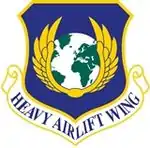Heavy Airlift Wing
The Heavy Airlift Wing (HAW) is an international military airlift organization based at Pápa Air Base, Hungary. It was officially activated on 27 July 2009 as part of the Strategic Airlift Capability (SAC) program,[1] which purchased and operates three C-17 Globemaster III aircraft that fly under the national markings of Hungary. The Heavy Airlift Wing is currently commanded by a Colonel from the United States Air Force, and is composed of up to 155 military personnel from the 12 participating nations, Bulgaria, Estonia, Finland, Hungary, Lithuania, the Netherlands, Norway, Poland, Romania, Slovenia, Sweden, and the United States. Strategic Airlift Capability nations send their personnel to work for the Heavy Airlift Wing on temporary or permanent positions.
| Heavy Airlift Wing | |
|---|---|
 | |
| Active | 2009– current (Full Operational Capability 2012) |
| Country | International military airlift organization consisting of Bulgaria, Estonia, Finland, Hungary, Lithuania, the Netherlands, Norway, Poland, Romania, Slovenia, Sweden and USA. |
| Branch | Air Force |
| Type | Strategic Airlift |
| Size | three C-17 Globemaster III aircraft 145 multinational military personnel |
| Part of | Strategic Airlift Capability |
| Garrison/HQ | Pápa Air Base, Hungary |
| Motto(s) | Team – Mission – Future |
| Anniversaries | 27 July |
| Commanders | |
| Current commander | Colonel James S. Sparrow, USAF |

From day one, the SAC nations requested missions in order to meet their obligations to employ/deploy/redeploy forces and equipment in support of national, UN, EU, NATO obligations, exercises, training and humanitarian relief, including the International Security Assistance Force 2009–2014, and the Resolute Support Mission, 2015– in Afghanistan. Operation Unified Protector in Libya, 2011. United Nations Multidimensional Integrated Stabilization Mission in Mali, 2013–. The EUFOR RCA, 2014–2015. The United Nations Multidimensional Integrated Stabilization Mission in the Central African Republic, 2015–. The wing has also conducted missions to provide logistical support to the investigation of the 2014 Malaysia Airlines MH17 crash in Ukraine. Significant humanitarian operations supported by the wing include earthquake relief in Haiti, 2010, flood relief in Pakistan, 2010, and hurricane relief to the island of St. Maarten, 2017. Mission execution has been successful, safe and cost-effective. Since 2009, the HAW have demonstrated what can be accomplished when resources and expertise are pooled and shared.
The HAW is independent of any command by NATO, European Union, United Nations, but is overseen by the SAC Steering Board and are supported by the NATO Airlift Management Programme Office (NAM PO). The NAM PO sources the majority of the technical, logistic, and training support to the SAC C-17 fleet from the United States Government through its Foreign Military Sales (FMS) programs, including C-17 maintenance which are contracted with Boeing.
Wing leadership
The leadership positions of the Heavy Airlift Wing are manned by the member nations with the biggest share of flight hours in the SAC program, the United States, Sweden, the Netherlands and Norway.[2]
Colonel James S. Sparrow of the United States Air Force is the Commander of the HAW.
Colonel Peder Söderström of the Swedish Air Force is the Vice Commander of the Heavy Airlift Wing.
Chief Master Sergeant Troy Barber of the United States Air Force is the Senior Enlisted Advisor of the HAW.
Heavy Airlift Wing Units
The Heavy Airlift Wing consists of HAW Command Staff, Command and Control Squadron (C2S), Heavy Airlift Squadron (HAS) and Logistics Support Squadron (LSS).[2]
HAW Command Staff
The HAW Command Staff consist of functions for the Wing Administrational Office (HAW Admin), Executive Assistance (HAW Exec), Protocol, Medical, Public Affairs, Legal Advisory, Safety and Quality Assurance.[2]
The Command Staff is led by the HAW Chief of Staff with HAW Quality Manager overseeing the Quality Assurance and Safety sections.
Command and Control Squadron
The Heavy Airlift Wing Command and Control Squadron (C2S) is the focal point for all interaction within the HAW and between wing and the SAC nations regarding their operational airlift requirements.[2]
The function of the C2S is to receive operational requirements for airlift from nations and convert them into actionable mission taskings. The C2S ensures that the requested missions are executable politically and that the desired payload is transportable by air.
It also defines the mission priority and helps to set the Required Delivery Date. C2S works in close cooperation with SAC support organization NATO Airlift Management Programme Office, Pápa Air Base and the Boeing team in Pápa to make sure that all the operational, administrational and technical support are there to make the airlift mission happen.
C2S staff is divided into three sections; Mission Planning and Execution, Diplomatic Clearance and Administrative Support. It is also especially multinational as seven of the twelve SAC nations (Finland, Hungary, the Netherlands, Norway, Poland, Romania, Slovenia, and Sweden) are represented in the personnel of the C2S.
Heavy Airlift Squadron (HAS)

The Heavy Airlift Squadron (HAS) is the world's first and only multinational C-17 operations squadron.[2]
HAS consists of the Heavy Airlift Wing flight crews and specialized functions for Intelligence, Tactics, Training, Standardization and Evaluation, HAW Combat Security and Aviation Management.
HAS's heritage is rooted in the training, policies and standards of the US air mobility system that is the basis of operations of the United States Air Force, the main user of the C-17.
The HAS has also adapted the best practices of C-17 sister squadrons in the USAF, Royal Canadian Air Force, Royal Australian Air Force and the United Kingdom's Royal Air Force.
The squadron structure, policies and procedures are designed to operate in support of the Strategic Airlift Capability nations' strategic policies to include combat and humanitarian airlift wherever and whenever they require it.
The HAS flight crews have a varied background of flying and working with cargo aircraft, fighter jets and helicopters in their national armed forces. Apart from the US personnel, none of them have C-17 training before joining the HAW.
After C-17 training has been carried out both in the United States and in Pápa, HAS aircrews are capable of reaching a high level of skill in utilizing the various capabilities of the aircraft.
Currently the HAS is the only C-17 Foreign Military Sales (FMS) unit that is trained and capable of performing the entire spectrum of C-17 Airland and Airdrop Mission Capabilities, including Heavy Equipment (HE), Container Delivery System (CDS) pallets and Personnel (PERS). The HAS is also Air Refueling qualified.
Logistics Support Squadron (LSS)
The Logistics Support Squadron (LSS) is in charge of providing the Heavy Airlift Wing with a variety of functions. It consists of sections for Maintenance, Supply, Aerial Port and Life Support.[2]
LSS Flying Crew Chiefs (FCCs), specialists of aircraft maintenance, travel with the C-17s as a part of the crew to perform maintenance at en-route locations. Vehicle Management ensures that SAC vehicles are in top condition for licensed drivers to use. The LSS Supply works in conjunction with the Boeing Company to ensure parts and support equipment are available to the aircraft maintainers, both at home station as well as en route. LSS Life Support ensures that Aircrew Flight Equipment is maintained for the safety of the aircrew.
LSS Aerial Port ensures safe loading and unloading of passengers and cargo at home station and ensures compliance with Dangerous Goods Regulations at all aerial ports where SAC C-17s pick up cargo from.
In addition to all these items, LSS works continuously with Pápa Air Base and the civilian authorities of Hungary on many support issues such as fuels, ground transportation, customs and other services.
References
- 12 nations activate groundbreaking Heavy Airlift Wing
- "Heavy Airlift Wing". www.sacprogram.org. Retrieved 30 October 2015.
External links
| Wikimedia Commons has media related to Strategic Airlift Capability Program. |